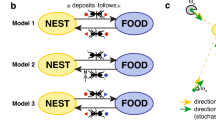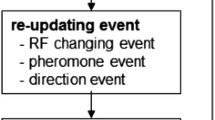Abstract
Faced with a choice of paths, an ant chooses a path with a higher concentration of pheromone. Subsequently, it drops pheromone on the path chosen. The reinforcement of the pheromone-following behavior favors the selection of an initially discovered path as the preferred path. This may cause a long path to emerge as the preferred path, were it discovered earlier than a shorter path. However, the shortness of the shorter path offsets some of the pheromone accumulated on the initially discovered longer path. In this paper, we model the trail formation behavior as a generalized Polya urn process. For k equal length paths, we give the distribution of pheromone at any time and highlight its sole dependence on the initial pheromone concentrations on paths. Additionally, we propose a method to incorporate the lengths of paths in the urn process and derive how the pheromone distribution alters on its inclusion. Analytically, we show that it is possible, under certain conditions, to reverse the initial bias that may be present in favor of paths that were discovered prior to the discovery of more efficient (shorter) paths. This addresses the Plasticity–Stability dilemma for ants, by laying out the conditions under which the system will remain stable or become plastic and change the path. Finally, we validate our analysis and results using simulations.
Similar content being viewed by others
References
Abraham, R., Dhersin, J. S., & Ycart, B. (2007). Strong convergence for urn models with reducible replacement policy. Journal of Applied Probability, 44(3), 652–660.
Bai, Z. D., Hu, F., & Rosenberger, W. F. (2002). Asymptotic properties of adaptive designs for clinical trials with delayed response. Annals of Statistics, 30(1), 122–139.
Beckers, R., Deneubourg, J.-L., & Goss, S. (1992). Trails and U-turns in the selection of a path by the ant Lasius niger. Journal of Theoretical Biology, 159, 397–415.
Carpenter, G., & Grossberg, S. (1987). A massively parallel architecture for a self-organizing neural pattern recognition machine. Computer Vision, Graphics and Image Processing, 37, 54–115.
Crimaldi, I., & Leisen, F. (2008). Asymptotic results for a generalized Polya urn with “multi-updating” and applications to clinical trials. Communication in Statistics. Theory and Methods, 37(17), 2777–2794.
Deneubourg, J.-L., Aron, S., Goss, S., & Pasteels, J.-M. (1990). The self-organizing exploratory pattern of the Argentine ant. Journal of Insect Behaviour, 3, 159–168.
Di Caro, G., & Dorigo, M. (1998). Ant colonies for adaptive routing in packet-switched communications networks. In A. E. Eiben, M. Schoenauer, & T. Back (Eds.), LNCS : Vol. 1498. Proceedings of PPSN V—fifth international conference on parallel problem solving from nature (pp. 673–682). Berlin: Springer.
Dirienzo, A. G. (2000). Using urn models for the design of clinical trials. Sankhyā: The Indian Journal of Statistics Series B, 62(1), 43–69.
Doerr, B., Neumann, F., Sudholt, D., & Witt, C. (2007). On the runtime analysis of the 1-ANT ACO algorithm. In D. Thierens et al. (Eds.), GECCO’07: Proceedings of the 9th annual conference on genetic and evolutionary computation (pp. 33–40). New York: ACM.
Dorigo, M., & Blum, C. (2005). Ant colony optimization theory: a survey. Theoretical Computer Science, 344, 243–278.
Dorigo, M., & Gambardella, L. M. (1997). Ant colony system: a cooperative learning approach to the traveling salesman problem. IEEE Transactions on Evolutionary Computation, 1(1), 53–66.
Dorigo, M., & Stützle, T. (2004). Ant colony optimization. Cambridge: MIT Press.
Eggenberger, F., & Pólya, G. (1923). Über die Statistik verketteter Vorgänge. ZAMM—Journal of Applied Mathematics and Mechanics, 3(4), 279–289.
Friedman, B. (1965). Bernard Friedman’s urn. Annals of Mathematical Statistics, 36, 956–970.
Flajolet, P., Dumas, P., & Puyhaubert, V. (2006). Some exactly solvable models of urn process theory. In P. Chassaing (Ed.), Discrete mathematics & theoretical computer science: Vol. AG. Fourth colloquium on mathematics and computer science algorithms, trees, combinatorics and probabilities (pp. 59–118). DMTCS Proceedings, Nancy, France.
Gouet, R. (1993). Martingale functional central limit theorems for a generalized Polya urn. Annals of Probability, 21(3), 1624–1639.
Gutjahr, W. J. (2000). A graph-based ant system and its convergence. Future Generation Computer Systems, 16, 873–888.
Gutjahr, W. J., & Sebastiani, G. (2008). Runtime analysis of ant colony optimization with best-so-far reinforcement. Methodology and Computing in Applied Probability, 10, 409–433.
Hardwick, J., Oehmke, R., & Stout, Q. F. (2001). Optimal adaptive designs for delayed response models: exponential case. In A. Atkinson, P. Hackl, & W. Müller (Eds.), MODA6: model oriented data analysis (pp. 127–134). Heidelberg: Physica Verlag.
Hardwick, J., Oehmke, R., & Stout, Q. F. (2006). New adaptive designs for delayed response models. Journal of Sequential Planning and Inference, 136, 1940–1955.
Hu, F., & Zhang, L.-X. (2004). Asymptotic normality of urn models for clinical trials with delayed response. Bernoulli, 10(3), 447–463.
Johnson, N., & Kotz, S. (1977). Urn models and their applications. New York: Wiley.
Kotz, S., Mahmoud, H. M., & Robert, P. (2000). On generalized Pólya urn models. Statistics and Probability Letters, 49, 163–173.
Lamb, A. E., & Ollason, J. G. (1994). Trail-laying and recruitment to sugary foods by foraging red wood-ants Formica aquilonia Yarrow (Hymenoptera: Formicidae). Behavioural Processes, 31, 111–124.
Leith, C. (2005). Ant algorithms and generalized finite urns. Ph.D. thesis, Queen’s University, Kingston, Ontario, Canada.
Mahmoud, H. M. (2003). Pólya urn models and connection to random trees: a review. Journal of the Iranian Statistical Society, 2(1), 53–114.
Mailleux, A.-C., Detrain, C., & Deneubourg, J.-L. (2004). Triggering and persistence of trail laying in foragers of the ant Lasius niger. Journal of Insect Physiology, 51, 297–304.
Maniezzo, V., & Colorni, A. (1999). The ant system applied to the quadratic assignment problem. IEEE Transactions on Data and Knowledge Engineering, 11(5), 769–778.
Merkle, D., & Middendorf, M. (2002). Modelling the dynamics of ant colony optimization algorithms. Evolutionary Computation, 10(3), 253–262.
Merkle, D., Middendorf, M., & Schmeck, H. (2002). Ant colony optimization for resource-constrained project scheduling. IEEE Transactions on Evolutionary Computation, 6(4), 333–346.
Neumann, F., & Witt, C. (2006). Runtime analysis of a simple ant colony optimization algorithm. In T. Asano (Ed.), LNCS : Vol. 4288. Proceedings of the 17th international symposium on algorithms and computation, ISAAC 2006 (pp. 618–627). Berlin: Springer.
Neumann, F., Sudholt, D., & Witt, C. (2008). Rigorous analyses for the combination of ant colony optimization and local search. In M. Dorigo, M. Birattari, C. Blum, M. Clerc, T. Stützle, & A. F. T. Winfield (Eds.), LNCS : Vol. 5217. Sixth international conference on ant colony optimization and swarm intelligence, ANTS 2008 (pp. 132–143). Berlin: Springer.
Neumann, F., Sudholt, D., & Witt, C. (2009). Analysis of different MMAS ACO algorithms on unimodal functions and plateaus. Swarm Intelligence, 3(1), 35–68.
Reimann, M., Doerner, K., & Hartl, R. F. (2003). Analyzing a unified ant system for the VRP and some of its variants. In G. Raidl, S. Cagnoni, J. J. R. Cardalda, D. W. Corne, J. Gottlieb, A. Guillot, E. Hart, C. G. Johnson, E. Marchiori, J. A. Meyer, & M. Middendorf (Eds.), LNCS : Vol. 2611. Applications of evolutionary computing: EvoWorkshops (pp. 300–310). Berlin: Springer.
Shah, S., Kothari, R., Jayadeva, & Chandra, S. (2008). Mathematical modeling and convergence analysis of trail formation. In D. Fox, & C. P. Gomes (Eds.), Proceedings of the twenty-third AAAI conference on artificial intelligence (pp. 170–175). Menlo Park: AAAI Press.
Stützle, T., & Dorigo, M. (2002). A short convergence proof for a class of ant colony optimization algorithms. IEEE Transactions on Evolutionary Computation, 6(4), 358–365.
Zhang, L.-X., Hu, F., & Cheung, S. H. (2006). Asymptotic theorems of sequential estimation-adjusted urn models. The Annals of Applied Probability, 16(1), 340–369.
Author information
Authors and Affiliations
Corresponding author
Rights and permissions
About this article
Cite this article
Shah, S., Kothari, R., Jayadeva et al. Trail formation in ants. A generalized Polya urn process. Swarm Intell 4, 145–171 (2010). https://doi.org/10.1007/s11721-010-0041-9
Received:
Accepted:
Published:
Issue Date:
DOI: https://doi.org/10.1007/s11721-010-0041-9




